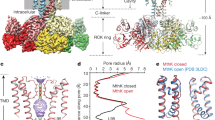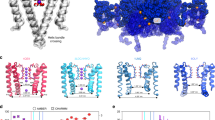Abstract
In many physiological systems such as neurotransmitter release, smooth muscle relaxation and frequency tuning of auditory hair cells, large-conductance calcium-activated potassium (BKCa) channels create a connection between calcium signalling pathways and membrane excitability1,2,3,4. BKCa channels are activated by voltage and by micromolar concentrations of intracellular calcium. Although it is possible to open BKCa channels in the absence of calcium5,6,7,8,9, calcium binding is essential for their activation under physiological conditions. In the presence of intracellular calcium, BKCa channels open at more negative membrane potentials5,10,11,12,13,14. Many experiments investigating the molecular mechanism of calcium activation of the BKCa channel have focused on the large intracellular carboxy terminus, and much evidence supports the hypothesis that calcium-binding sites are located in this region of the channel. Here we show that BKCa channels that lack the whole intracellular C terminus retain wild-type calcium sensitivity. These results show that the intracellular C terminus, including the ‘calcium bowl’ and the RCK domain, is not necessary for the calcium-activated opening of these channels.
This is a preview of subscription content, access via your institution
Access options
Subscribe to this journal
Receive 51 print issues and online access
$199.00 per year
only $3.90 per issue
Buy this article
- Purchase on Springer Link
- Instant access to full article PDF
Prices may be subject to local taxes which are calculated during checkout




Similar content being viewed by others
References
Nelson, M. T. et al. Relaxation of arterial smooth muscle by calcium sparks. Science 270, 633–637 (1995)
Lewis, R. S. & Hudspeth, A. J. Voltage- and ion-dependent conductances in solitary vertebrate hair cells. Nature 304, 538–541 (1983)
Robitaille, R., Garcia, M. L., Kaczorowski, G. J. & Charlton, M. P. Functional colocalization of calcium and calcium-gated potassium channels in control of transmitter release. Neuron 11, 645–655 (1993)
Crawford, A. C. & Fettiplace, R. An electrical tuning mechanism in turtle cochlear hair cells. J. Physiol. (Lond.) 312, 377–412 (1981)
Cui, J., Cox, D. H. & Aldrich, R. W. Intrinsic voltage dependence and Ca2+ regulation of mslo large conductance Ca-activated K+ channels. J. Gen. Physiol. 109, 647–673 (1997)
Stefani, E. et al. Voltage-controlled gating in a large conductance Ca2+-sensitive K+ channel (hslo). Proc. Natl Acad. Sci. USA 94, 5427–5431 (1997)
Horrigan, F. T., Cui, J. & Aldrich, R. W. Allosteric voltage gating of potassium channels I. Mslo ionic currents in the absence of Ca2+. J. Gen. Physiol. 114, 277–304 (1999)
Talukder, G. & Aldrich, R. W. Complex voltage-dependent behavior of single unliganded calcium-sensitive potassium channels. Biophys. J. 78, 761–772 (2000)
Nimigean, C. M. & Magleby, K. L. The β subunit increases the Ca2+ sensitivity of large conductance Ca2+-activated potassium channels by retaining the gating in the bursting states. J. Gen. Physiol. 113, 425–440 (1999)
Marty, A. Ca2+-dependent K+ channels with large unitary conductance in chromaffin cell membranes. Nature 291, 497–500 (1981)
Pallotta, B. S., Magleby, K. L. & Barrett, J. N. Single channel recordings of Ca2+-activated K+ currents in rat muscle cell culture. Nature 293, 471–474 (1981)
Cox, D. H., Cui, J. & Aldrich, R. W. Allosteric gating of a large conductance Ca2+-activated K+ channel. J. Gen. Physiol. 110, 257–281 (1997)
Rothberg, B. S. & Magleby, K. L. Gating kinetics of single large-conductance Ca2+-activated K+ channels in high Ca2+ suggest a two-tiered allosteric gating mechanism. J. Gen. Physiol. 114, 93–124 (1999)
Rothberg, B. S. & Magleby, K. L. Voltage and Ca2+ activation of single large-conductance Ca2+-activated K+ channels described by a two-tiered allosteric gating mechanism. J. Gen. Physiol. 116, 75–99 (2000)
Schreiber, M. & Salkoff, L. A novel calcium-sensing domain in the BK channel. Biophys. J. 73, 1355–1363 (1997)
Schreiber, M., Yuan, A. & Salkoff, L. Transplantable sites confer calcium sensitivity to BK channels. Nature Neurosci. 2, 416–421 (1999)
Wei, A., Solaro, C., Lingle, C. & Salkoff, L. Calcium sensitivity of BK-type KCa channels determined by a separable domain. Neuron 13, 671–681 (1994)
Bian, S., Favre, I. & Moczydlowski, E. Ca2+-binding activity of a COOH-terminal fragment of the Drosophila BK channel involved in Ca2+-dependent activation. Proc. Natl Acad. Sci. USA 98, 4776–4781 (2001)
Braun, A. F. & Sy, L. Contribution of potential EF hand motifs to the calcium-dependent gating of a mouse brain large conductance, calcium-sensitive K+ channel. J. Physiol. (Lond.) 533, 681–695 (2001)
Bao, L., Rapin, A. M., Holmstrand, E. C. & Cox, D. H. Elimination of the BKCa channel's high-affinity Ca2+ sensitivity. J. Gen. Physiol. 120, 173–189 (2002)
Xia, X. M., Zeng, X. & Lingle, C. J. Multiple regulatory sites in large-conductance calcium-activated potassium channels. Nature 418, 880–884 (2002)
Jiang, Y. et al. Crystal structure and mechanism of a calcium-gated potassium channel. Nature 417, 515–522 (2002)
Bravo-Zehnder, M. et al. Apical sorting of a voltage- and Ca2+-activated K+ channel α-subunit in Madin–Darby canine kidney cells is independent of N-glycosylation. Proc. Natl Acad. Sci. USA 97, 13114–13119 (2000)
Quirk, J. C. & Reinhart, P. H. Identification of a novel tetramerization domain in large conductance KCa channels. Neuron 32, 13–23 (2001)
Krause, J. D., Foster, C. D. & Reinhart, P. H. Xenopus laevis oocytes contain endogenous large conductance Ca2+-activated K+ channels. Neuropharmacology 35, 1017–1022 (1996)
Shen, K. Z. et al. Tetraethylammonium block of Slowpoke calcium-activated potassium channels expressed in Xenopus oocytes: evidence for tetrameric channel formation. Pflugers Arch. 426, 440–445 (1994)
Niu, X. & Magleby, K. L. Stepwise contribution of each subunit to the cooperative activation of BK channels by Ca2+. Proc. Natl Acad. Sci. USA 99, 11441–11446 (2002)
Zhu, G., Zhang, Y., Xu, H. & Jiang, C. Identification of endogenous outward currents in the human embryonic kidney (HEK 293) cell line. J. Neurosci. Methods 81, 73–83 (1998)
Colquhoun, D. Binding, gating, affinity and efficacy: the interpretation of structure–activity relationships for agonists and of the effects of mutating receptors. Br. J. Pharmacol. 125, 924–947 (1998)
Horrigan, F. T. & Aldrich, R. W. Coupling between voltage-sensor activation, Ca2+ binding and channel opening in large conductance (BK) potassium channels. J. Gen. Physiol. 120, 267–305 (2002)
Acknowledgements
We thank S. Wiler for help with mutagenesis; and R. Lewis, M. Maduke, J. Trimmer, T. Middendorf, J. Sack and S. Pyott for critically reading the manuscript. R.P. was supported by a training grant from the National Institutes of Health. R.W.A is an investigator for the Howard Hughes Medical Institute.
Author information
Authors and Affiliations
Corresponding author
Ethics declarations
Competing interests
The authors declare that they have no competing financial interests.
Rights and permissions
About this article
Cite this article
Piskorowski, R., Aldrich, R. Calcium activation of BKCa potassium channels lacking the calcium bowl and RCK domains. Nature 420, 499–502 (2002). https://doi.org/10.1038/nature01199
Received:
Accepted:
Issue Date:
DOI: https://doi.org/10.1038/nature01199
This article is cited by
-
Understand spiciness: mechanism of TRPV1 channel activation by capsaicin
Protein & Cell (2017)
-
Neuronal fast activating and meningeal silent modulatory BK channel splice variants cloned from rat
Pflügers Archiv - European Journal of Physiology (2011)
-
Polyunsaturated Fatty Acid Modulation of Voltage-Gated Ion Channels
Cell Biochemistry and Biophysics (2008)
-
High-conductance potassium channels of the SLO family
Nature Reviews Neuroscience (2006)
-
Intracellular Mg2+ Influences Both Open and Closed Times of a Native Ca2+-activated BK Channel in Cultured Human Renal Proximal Tubule Cells
Journal of Membrane Biology (2005)
Comments
By submitting a comment you agree to abide by our Terms and Community Guidelines. If you find something abusive or that does not comply with our terms or guidelines please flag it as inappropriate.



